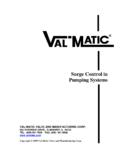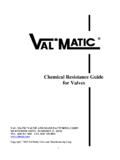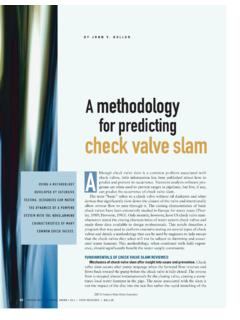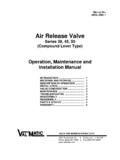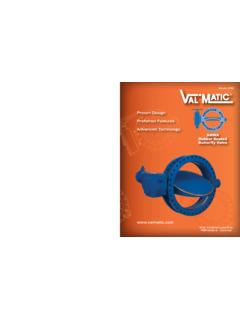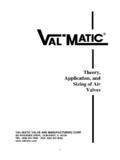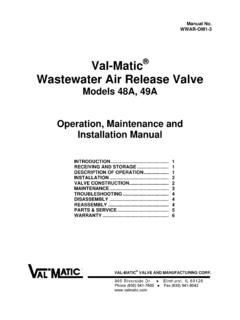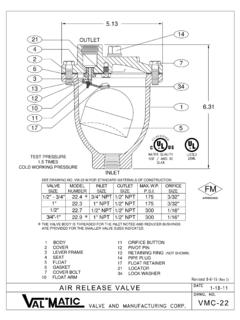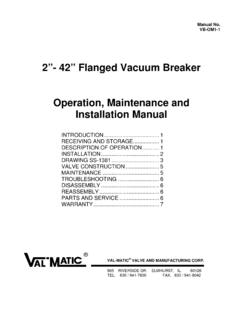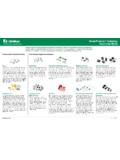Transcription of Bulletin 1500 AIR VALVES - Val-Matic Valve & Mfg
1 V Bulletin 1500 . AIR VALVES . PROVIDING. SYSTEM. EFFICIENCY. AND. PROTECTION. NSF/ANSI 61. Certified TABLE OF CONTENTS. UNDERSTANDING AIR VALVES . Air and Its Impact on a Water and Wastewater System pp. 3-7. Features and Benefits pp. 8-9. AIR Valve APPLICATIONS. Look to Val-Matic for Solutions p. 10. Applications, Functions, Purpose and Features p. 11. TECHNICAL DATA. Air Release VALVES pp. 12-13. Air/Vacuum VALVES pp. 14-15. Combination Air VALVES pp. 16-19. Surge-Suppression Air VALVES pp. 20-21. Well Service Air VALVES pp. 22-23. Vacuum Breaker VALVES pp. 24-25. Vacuum Priming VALVES p. 26. 2. Air Valve Sizing Software p. 27. V. AIR&. Its Impact on a Water and Wastewater System O. ne of the most misunderstood aspects of the Vertical Pump Water & Wastewater industry is the presence Well Service Air Valve of air in a pipeline and its impact on opera- Check Valve tions.
2 Many operational problems, especially at the time of initial start-up, including broken pumps, VALVES and FLOW. pipe, as well as faulty instrumentation readings, are blamed on inadequate thrust blocking, improper pipeline bedding, etc. In reality, many of these problems are not caused by improper installation of the line, but by failure to de-aerate the line. Properly de-aerating your pipeline will safeguard it from air-related problems, however if no steps are taken to accomplish this, you should be ready for trouble. Water Level SOURCES OF AIR. Air in a pressurized, operating pipeline comes from three primary sources. First, prior to start-up, the line is not empty - it is full of air. To entirely fill a pipeline with fluid, it is necessary to eliminate this air. As the line fills, much of this air will be pushed downstream to be released through hydrants, faucets, etc.
3 But a large amount will become trapped at system high points (Figure 1). This phenomenon will occur because air is lighter than water Figure 2. Air entering through mechanical equipment AIR BUBBLES RISE. The third source of air is that which enters through AIR COLLECTS AT HIGH POINT. TO HIGHT POINT. INCREASING IN SIZE. mechanical equipment (Figure 2). This includes air being forced into the system by pumps as well as air being drawn in through packing, VALVES , etc. under vacuum con- OW. FL ditions. As one can see, a pressurized pipeline is never without air and typically the volume is substantial. IMPACT OF AIR ON SYSTEM. Figure 1. Air in pipeline collects at high points Now that we have identified the air sources, let us consider their impact on the system. Two problems are apparent. and therefore, will collect at the high points. This air will The pocket(s) of air accumulating at a high point(s) can continuously be added to by the second and third sources result in a line restriction (Figure 3).
4 Like any restriction, the as the system continues operation. AIR BUBBLES AIR COLLECTS AT HIGH POINT. RISE TO HIGH POINT. Source number two is the water itself. Water contains INCREASING IN SIZE. approximately 2% air by volume. During system opera- tion, the entrained air will continuously separate out of the OW. FL. water and once again accumulate at system high points. To illustrate the potential massive amount of air this 2%. represents, consider the following: A 1000 ft. length of RESTRICTED FLOW. pipe could contain a pocket of air 20 ft. long if all the air INCREASED VELOCITY. INCREASED HEAD LOSS. accumulated in one location. Or a one mile length of pipe could contain a 100 ft. pocket of air. This would be true Figure 3. Air pockets can lead to line restriction regardless of the diameter of the pipe. 3. Air in a pressurized pipeline is a serious concern. Obviously, its removal will result in a more efficient, cost effective operation and potentially avoid more serious problems.
5 Pocket(s) of air increases headloss, extends pumping can and often will, lead to a high pressure surge (water cycles and increases energy consumption. The presence of hammer). Serious damage to VALVES , fittings, gaskets, or air can also promote corrosion of pipe and fittings. As air even breakage of the line can occur. This is the most continues to accumulate at system high points, the fluid serious of the possible consequences of air being allowed velocity increases as the fluid is forced through a smaller to accumulate in system high points. and smaller opening. HISTORICAL SOLUTIONS. As we can see, air in a pressurized pipeline is a serious W. F LO concern. Obviously, its removal will result in a more effi- cient, cost effective operation and potentially avoid more serious problems. In the early 1900's, engineers and water works personnel started developing an understanding of Figure 4 the problems associated with air and the search for a solu- Air pockets can lead to total flow stoppage tion began.
6 Some depended on standpipes, believing that a large portion of the air would be expelled through them. As the pocket(s) grows, one of two phenomena will occur. The first possibility is a total flow stoppage (Figure 4). If sys- Hydrant tem dynamics are such that the air cannot be continuously removed by the increased fluid velocity and pushed down- stream, then this could happen. As the pocket(s) contin- ues to accumulate air, a pressure drop higher than pump capacity can develop and stop all flow. The second, and more likely occurrence, is that the increased velocity will cause all, or part of, the pocket to suddenly dislodge and be pushed downstream (Figure 5). The sudden and rapid change in fluid velocity when the pocket dislodges and is then stopped by another high point, Air Pocket OW. FL. Butterfly Valve Distribution Line Figure 6. Opening a hydrant may not eliminate air pockets OW Many began placing gate or ball VALVES at system high points FL to manually bleed off accumulated air.
7 Unfortunately, it has proved impossible to predict when it is time to bleed the air. Part of air pocket breaks This proved impractical, especially on larger systems. Open away, creating surge fire hydrants (Figure 6) are frequently used under the assumption that all air in the pipeline will be released. Unfortunately, hydrants are generally connected to the side Figure 5 of the pipe, leaving air trapped at the top and at system Air pockets can lead to surges in the line high points. It should be noted that there are still munici- palities using these methods. 4. An added benefit of an Air/Vacuum Valve is its ability to provide pipeline vacuum protection. If a negative pressure develops, the Valve will open, admitting air into the line, reducing the potential for surges related to column separation and possible pipeline collapse.. AIR EXHAUST. THE AIR Valve SOLUTION.
8 Today, most municipalities utilize Automatic Air VALVES . They are available in many different designs and configurations for a wide range of applications. Their function is to automatically release and admit air without WATER LEVEL. operator assistance. Today, countless Air VALVES are WATER LEVEL. performing this task around the globe on a daily basis. Air VALVES are available in three basic configurations AIR ENTERING. Valve . (Figure 7): Air Release VALVES , Air/Vacuum VALVES and CLOSED OPEN. Combination Air VALVES . Correct sizing and location of all POSITION POSITION. three types are critical. Every high point greater than one Figure 8. pipe diameter where the pipeline converts from a positive Air Release Valve in Operation grade to a negative grade requires an air Valve . Even min- imal high points with small air pockets can cause serious by water, raising the float and closing the Valve orifice.
9 As surge problems and reduce line efficiency. In addition, it air accumulates, the Valve will continue to cycle in this is recommended that air VALVES be installed every half manner to remove collected air. mile or 2500 feet on straight horizontal runs (AWWA. M51). Air Valve Sizing Software is available, see page 27. AIR/VACUUM VALVES . Air/Vacuum VALVES (Figure 9), sometimes referred to as Air Release Valve "large orifice" VALVES , are used to exhaust large quantities of air upon system start-up, as well as allowing air to re- enter the line upon system shut down or system failure. As water enters the Valve , the float will rise, closing the dis- charge port. The Valve will remain closed until system pressure drops to near zero psi. It will not open to release any accumulation of air while the system is under pres- sure. AIR EXHAUSTING. Combination Air Valve OPEN.
10 Air exhausted during pipeline fill Air/Vacuum Valve Figure 7 WATER LEVEL. Basic Air Valve configurations CLOSED. Pipeline under AIR INTAKE. AIR RELEASE VALVES pressure An Air Release Valve (Figure 8), sometimes referred to as a "small orifice" Valve , will continuously release accumu- lated air during system operation. As air from the pipeline enters the Valve , it displaces the water, allowing the float OPEN. Air enters during to drop. The air is then released into the atmosphere pipeline draining through a small orifice. As the air is vented it is replaced Figure 9. Air/Vacuum Valve Operation 5. An added benefit of an Air/Vacuum Valve is its ability to severe vacuum pocket and the damaging pressures that provide pipeline vacuum protection. If a negative pressure can occur when these pockets collapse. When the water develops, the Valve will open, admitting air into the line, columns rejoin and the pressure recovers, the air Valve reducing the potential for surges related to column separa- should exhaust the air in a regulated manner to suppress tion and possible pipeline collapse.
